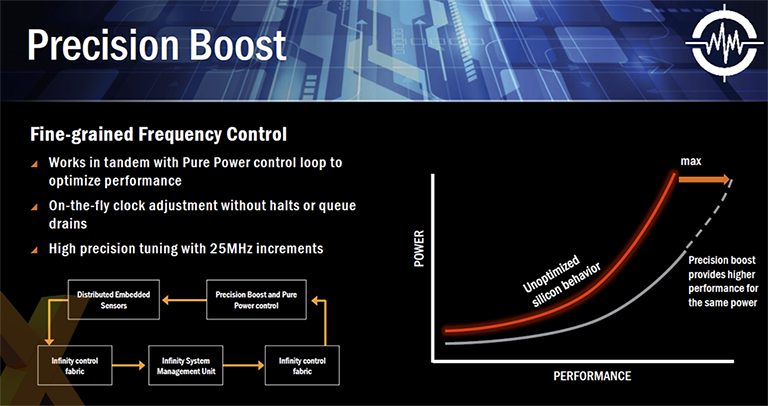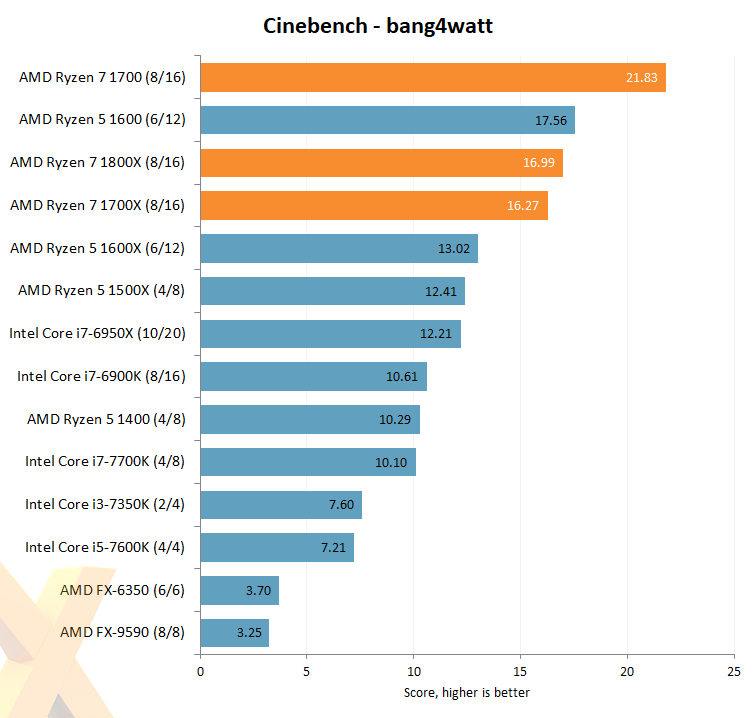Ryzen 7 Smart Efficiency
AMD's recent release of Ryzen 7 processors brought much-needed competition back in the performance sphere of desktop computing. And competition doesn't mean just pure speed, because any modern, cutting-edge processor needs to balance straight-line prowess with energy efficiency. The reason for this is the base architecture will likely span multiple markets that have varying limitations on how much power can be fed into the processor. The upshot is that a scalable design needs to have an excellent performance-per-watt characteristic if it is to succeed in all areas.
We already know that Ryzen 7, comprising an eight-core, 16-thread topology based on the potent Zen architecture, is excellent when pushed to the limit. Ryzen 7's multi-threaded performance matches the very best that Intel has to offer, making it an ideal choice for the power user, but, and it's a big one, Ryzen 7 is able to do all that whilst consuming less energy than Intel's latest processors. Indeed, their 95W TDP is well below the comparable 140W mandated for performance-equivalent chips from Intel.
So how has AMD been able to so marry performance to such excellent power efficiency? The answer, unsurprisingly, is in making the right calls on this clean-sheet architecture.
All Ryzen 7 chips are built on the leading-edge 14nm FinFET manufacturing process that lends itself to energy efficiency. The tiny size of the transistors means that less current is used to drive them than older processes such as 28nm, on which previous-generation AMD chips are built. Requiring less power to achieve a particular frequency automatically lends itself to lower energy consumption. In other words, AMD uses the best manufacturing techniques to ensure it can pack in as much compute power as possible at a particular thermal budget. That, in a sense, is the easy, expected part.
Yet Ryzen 7 has far more under the hood to ensure that every single milliwatt of power is used correctly. This intelligent design comes under a group of technologies called SenseMI, and you can learn more about the overarching technology here.

The first constituent part of SenseMI is Pure Power. Its aim is to use energy as wisely as possible. That can only happen if there is excellent reporting and feedback on how Ryzen 7 is performing at all times. To this end, AMD has endowed Ryzen 7 with over 1,000 sensors that poll the chip at over 1,000 times a second. All this information is collated by the control logic and then used to set the lowest, most efficient voltage for a given workload, maximising efficiency.

The other side of the coin is maximising performance for a given amount of power. You want a processor to do a set amount of work at the lowest power level or, when running full chat, the most amount of work without going over the thermal design limit. This is where Precision Boost comes in. The Ryzen 7 processor is able to shift up and down the frequency curve in 25MHz increments, on-the-fly, and without any user intervention. It maximises performance when there is scope to do so, in a way that has not been possible before. This means it is able to run at higher per-core frequency, for more of the time, without using additional power.
SenseMI, as you may have guessed, is a fully automated system that runs oblivious to the user. Given how improved cooling will change the way in which SenseMI implements frequency, with the potential to go higher if there is sufficient headroom on the various characteristics to do so, Ryzen has an additional, automated mode called eXtended Frequency Range (XFR).
This mode, active when SenseMI spies improved cooling - high-end air, watercooling, etc. - enables Ryzen 7 to boost to a higher-than-normal frequency state. The exact amount of headroom depends upon chip and quality of cooling, but we expect to see another 100MHz available, stepped up in the granular 25MHz increments.
What all of this means is that Ryzen 7 is both fast and energy efficient, thanks to cutting-edge manufacturing paired with intelligent design. Energy efficiency is further augmented by having smart caches that power down quickly, low latencies between different parts of the chip, and area- and power-efficient simultaneous multithreading that gives each Ryzen 7 processor the ability to execute 16 threads in parallel.
To illustrate just how efficiently Ryzen 7 is able to mete out lots of performance in a restrained 95W TDP, the following graph divides the multithreaded Cinebench score against the TDP (thermal design point).

What we see is that AMD takes the first six slots that define energy efficiency, and the trio of Ryzen 7 chips are fundamentally better in this regard than any performance Intel processor. Think energy efficiency and performance, think Ryzen 7.
AMD Ryzen 7 processors are available at the following retailers:








